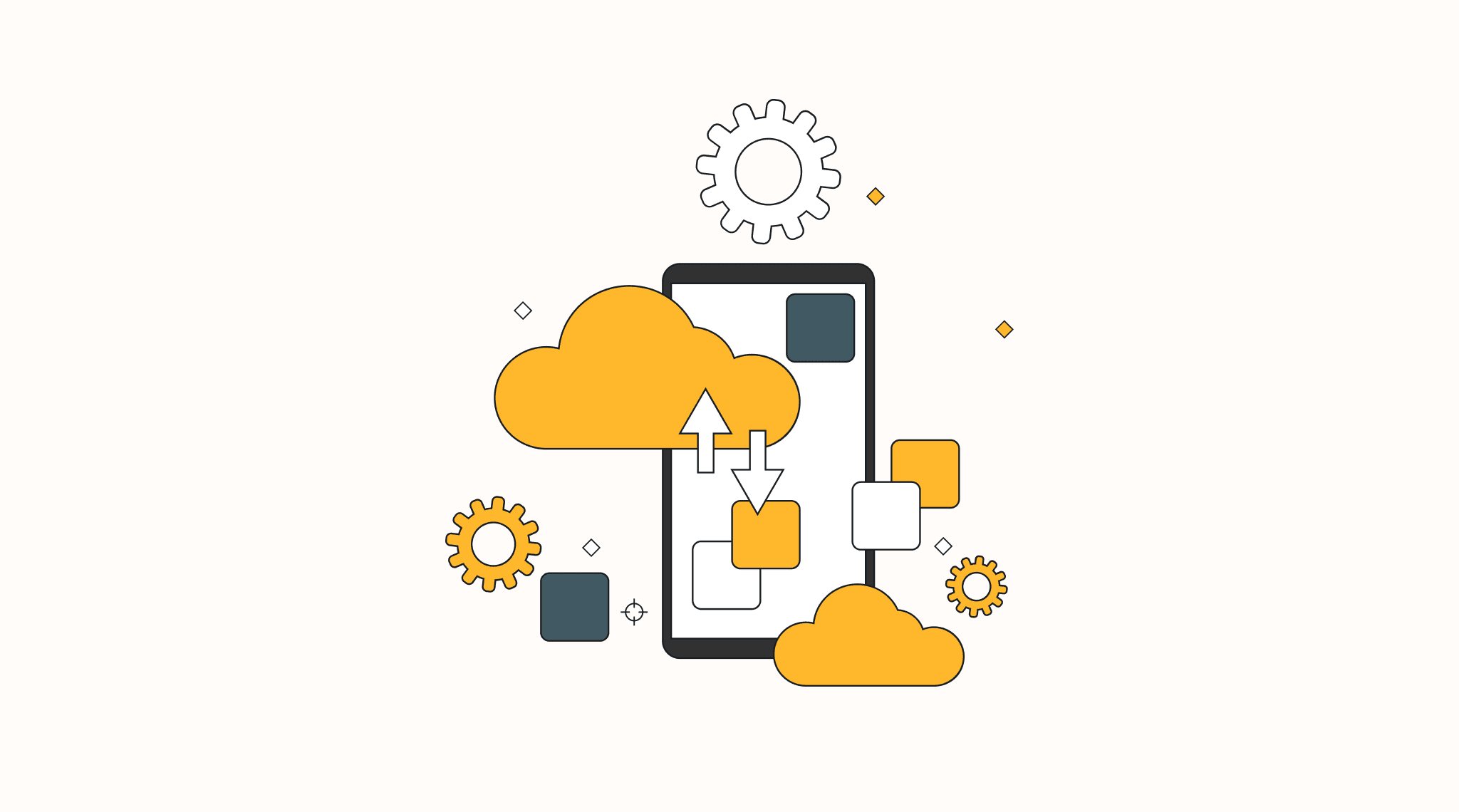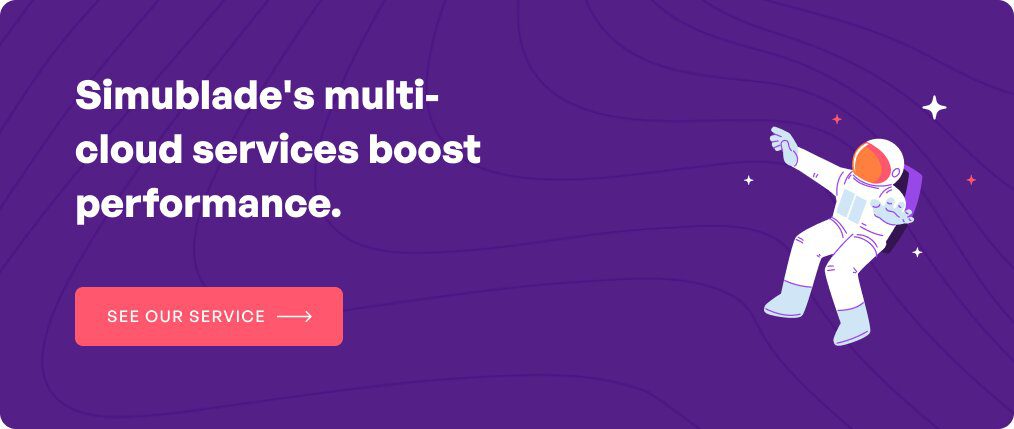Multi-cloud refers to cloud computing services of several public clouds from different vendors who are typically not connected to one another. These are built on open-source and cloud-native technologies like Kubernetes and let businesses run workload on many clouds rather than being restricted to a single system. For instance, Netflix previously delivered services only via Amazon Web Services (AWS) but has shifted to multi-cloud and included Google Cloud Platform into the ecosystem to cater to its AI needs and disaster recovery in a more streamlined manner. Further, most corporates use both Dropbox and Google Drive to store, manage or transfer data which is a common example of multi-cloud.
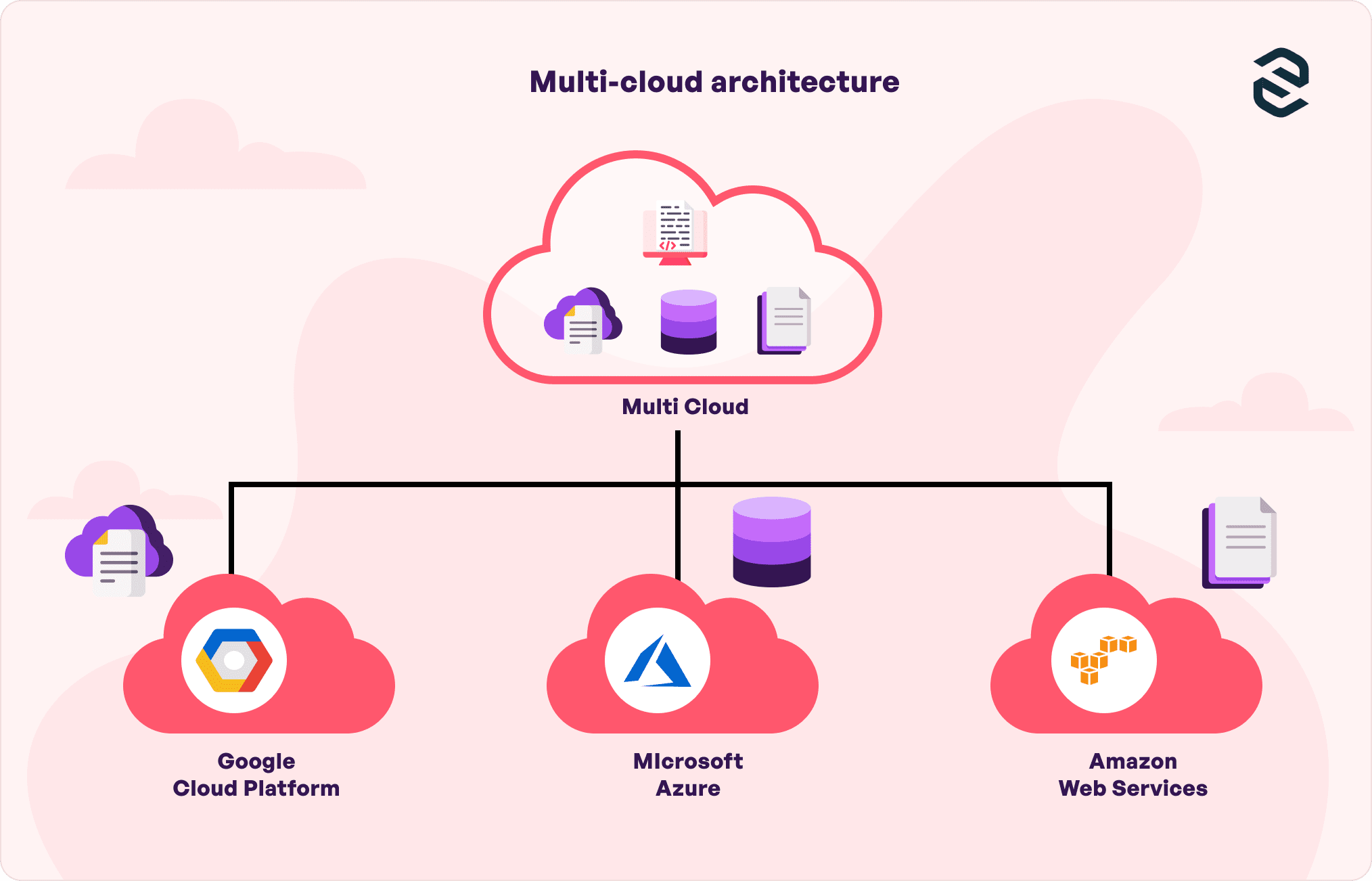
Overall, multi-cloud architecture offers ample choice to businesses to pick the best-suited environment for unique operations while ensuring there are no risks of a one-point failure. The good news is that despite a multi-vendor environment, the system is set up in a way to ensure seamless data flow among the clouds for smooth tracking while securing workloads. No wonder, 76% of organizations across the world are using multi-cloud in 2024 with one private and one shared operating model.
Now, this article provides a comprehensive guide on a multi-cloud strategy to help both startups and enterprises make informed decisions when upgrading efficiency, reliability, security, and flexibility of their businesses. Read on to find more.
Table of contents
What are the key benefits of multi-cloud architecture?
Utilizing multi-cloud solutions means running IaaS, SaaS or PaaS solutions from several service providers like Microsoft Azure and GCP. Generally, this is helpful to boost IT flexibility, proximity, reliability, and agility across all industries. Further, multi-cloud integration is a good investment for international companies since a single preferred platform might not be available in all regions where they operate.
In short, the role of cloud in digital transformation, be it hybrid or multi-cloud, becomes quite prominent since it leads to real-time synchronizations and exposure to sophisticated technologies and innovations to outshine competitors. Below are other significant benefits :
Cost-effectiveness
Minimizing IT spending is best done with a multi cloud strategy since businesses are required to pay only for the services they use. Additionally, the overhead cost of public cloud is low due to resources being shared with other businesses. Lastly, you can build in-person relationships with multiple providers and negotiate the total cost of ownership (TCO) which will include software licensing, infrastructure expenses, support expenses, and network bandwidth, regardless.
Better performance
One of the top benefits of multi-cloud strategy is high-end performance along with excellent frontend experience due to the following :
- moving and managing resources
- upscaling or downscaling as and when needed
- reliability with minimal unplanned downtime
- no geographical barriers to distribute services
- minimizes latency with intelligent work distribution
- super fast data transfer which speeds up the operations
Given these benefits, almost two-thirds or 64% of organizations worldwide predicted in 2024 that their multi-cloud usage will increase in the next 2 years.
No vendor lock-in
With multi-cloud, businesses are not forced to continue using a cloud service when it is not serving their purpose. You have the flexibility to choose where to deploy workloads which helps reduce inefficiencies, interoperability, and superfluous expenses. It also means organizations are no longer tied to the offerings of a single vendor, which usually limits growth potentials, but can seamlessly migrate to other lucrative options.
Compliance
The best multi cloud solutions typically have built-in regulatory compliance in terms of internal standards, privacy rules, and industry and regulatory requirements. It includes NIST, CIS, ISO, GDPR, and HIPAA which are typically consistent across all business workloads. These help lower the risks of cybersecurity, lawsuits, cloud misconfigurations, penalties, and reputational damage.
Fewer risks
A multi-cloud architecture is less prone to single point of failure (SPoF) and denial of service (DDoS) since they are built on fault tolerance and high resilience. Further, even if a cloud is compromised due to an outage, there are strong backups and recovery. This prevents losing core applications and critical data or vulnerabilities and security gaps which were quite usual in the older ways of data storage.
 Wondering how to start leveraging the benefits of multi-cloud strategy? Consider partnering with Simublade, a cloud computing solutions company in the heart of Houston. Our expert developers harness futuristic technologies to deploy multi-cloud, utilizing diverse providers to boost business performance. The cloud professionals here are also specialized in multiple other services like cloud app development and maintenance, cloud migration, and cloud consulting tailor to meet a plethora of scalability, storage, and security requirements.
Wondering how to start leveraging the benefits of multi-cloud strategy? Consider partnering with Simublade, a cloud computing solutions company in the heart of Houston. Our expert developers harness futuristic technologies to deploy multi-cloud, utilizing diverse providers to boost business performance. The cloud professionals here are also specialized in multiple other services like cloud app development and maintenance, cloud migration, and cloud consulting tailor to meet a plethora of scalability, storage, and security requirements.
Multi cloud vs. hybrid cloud : a comparison
Multi-cloud is the service of ‘multiple’ public cloud environments without any communications between them. For instance, a company might use AWS for data storage, Google Cloud Platform for testing and development, and Microsoft Azure for disaster management and recovery. So, there is no single management system, unified logging, or monitoring. Different clouds are responsible for different tasks which saves the company from paying for in-house systems or data centers.
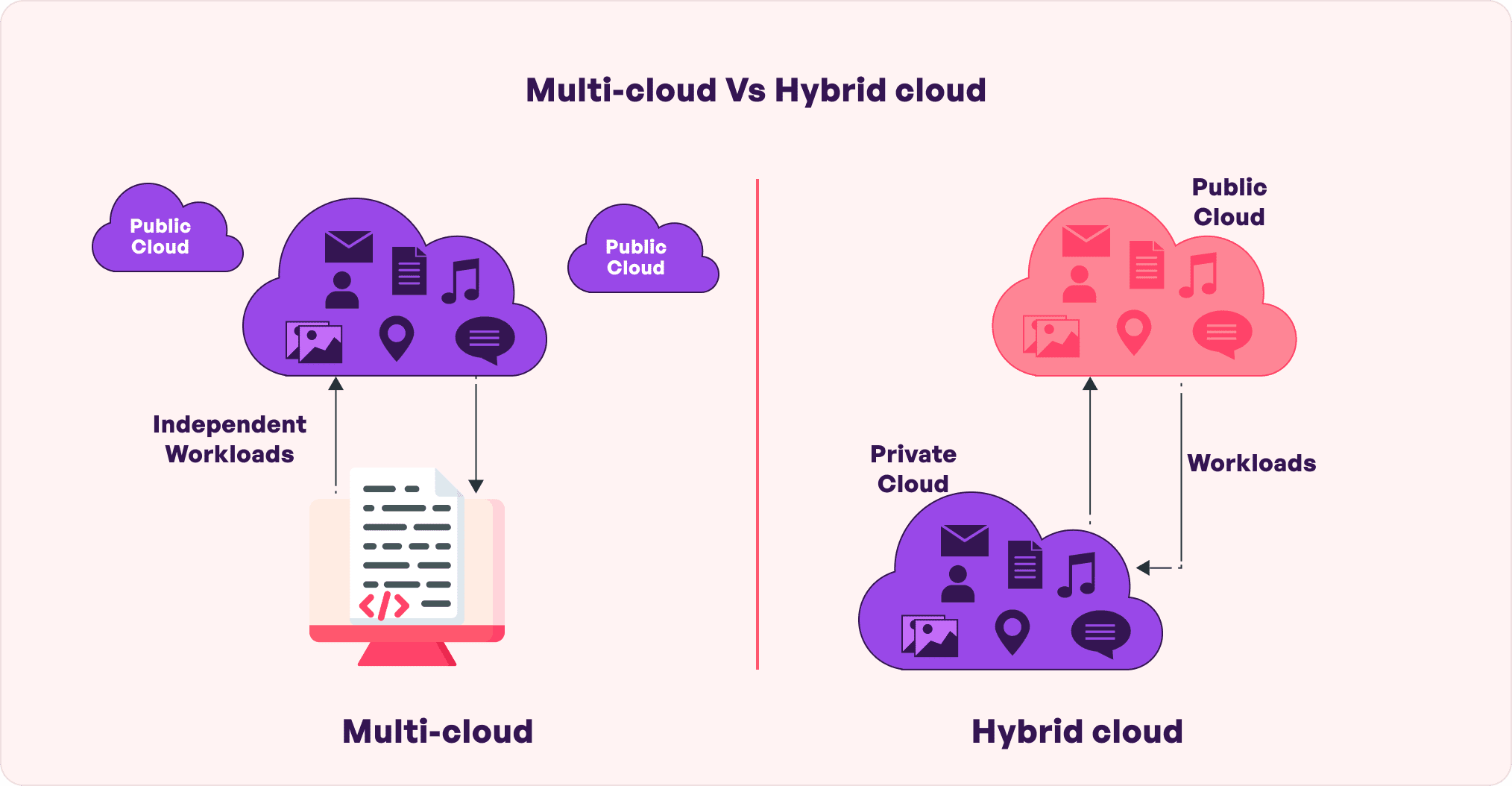 Hybrid cloud is the combined services of public cloud, on-premise data centers, and private environments with one management system, alerting stacks, and unified logging ensuring significant interconnectivity. In short, different components work together to run a single IT application and companies are liable to pay for the set up expenses.
Hybrid cloud is the combined services of public cloud, on-premise data centers, and private environments with one management system, alerting stacks, and unified logging ensuring significant interconnectivity. In short, different components work together to run a single IT application and companies are liable to pay for the set up expenses.
Knowing the difference between multi-cloud and hybrid cloud is critical since hybrid work culture is forcing C-suites to work on their digital transformation process to make sure businesses are able to pick the right architecture that works in their best interest.
Types of multi-cloud service models
Below is a basic understanding of the models that are used to build a cloud strategy:
1. SaaS or Software-as-a-Service
In this, cloud-based applications can be used on a subscription basis on the internet instead of one-time purchase. In fact when considering SaaS development services, cloud migration is quite a critical step. Example: Microsoft Office 365, Papaya Global, and HubSpot.
2. PaaS or Platform-as-a-Service
Infrastructure, hardware, and software are used to build and manage applications. This could be simple cloud-based apps or cloud-enabled high-end applications. Example: Windows Azure, Heroku, and OpenShift.
3. IaaS or Infrastructure-as-a-Service
This offers fundamental storage, compute, and network-related activities on a pay-as-you-go model which removes physical hardware and offers virtualization technology. Example: Amazon Web Services (AWS), IBM Cloud, and Cisco Metacloud.
Different multi cloud use cases for clarity
Multi cloud typically benefits industries dealing with enormous volumes of data including healthcare, retail, education, gaming, and manufacturing. Below are a few scenarios or use cases of the technology to help you make informed choices:
- a part of a company’s cloud backup strategy to avoid data loss
- support system of an organization when it wants to expand
- helpful to ensure round-the-cloud data availability
- cater to specific needs of different departments of a company
- manage a global customer base by avoiding latency issues
Below is an idea of the robust tech-stack that facilitates the above functions and altogether elevates your cloud game.
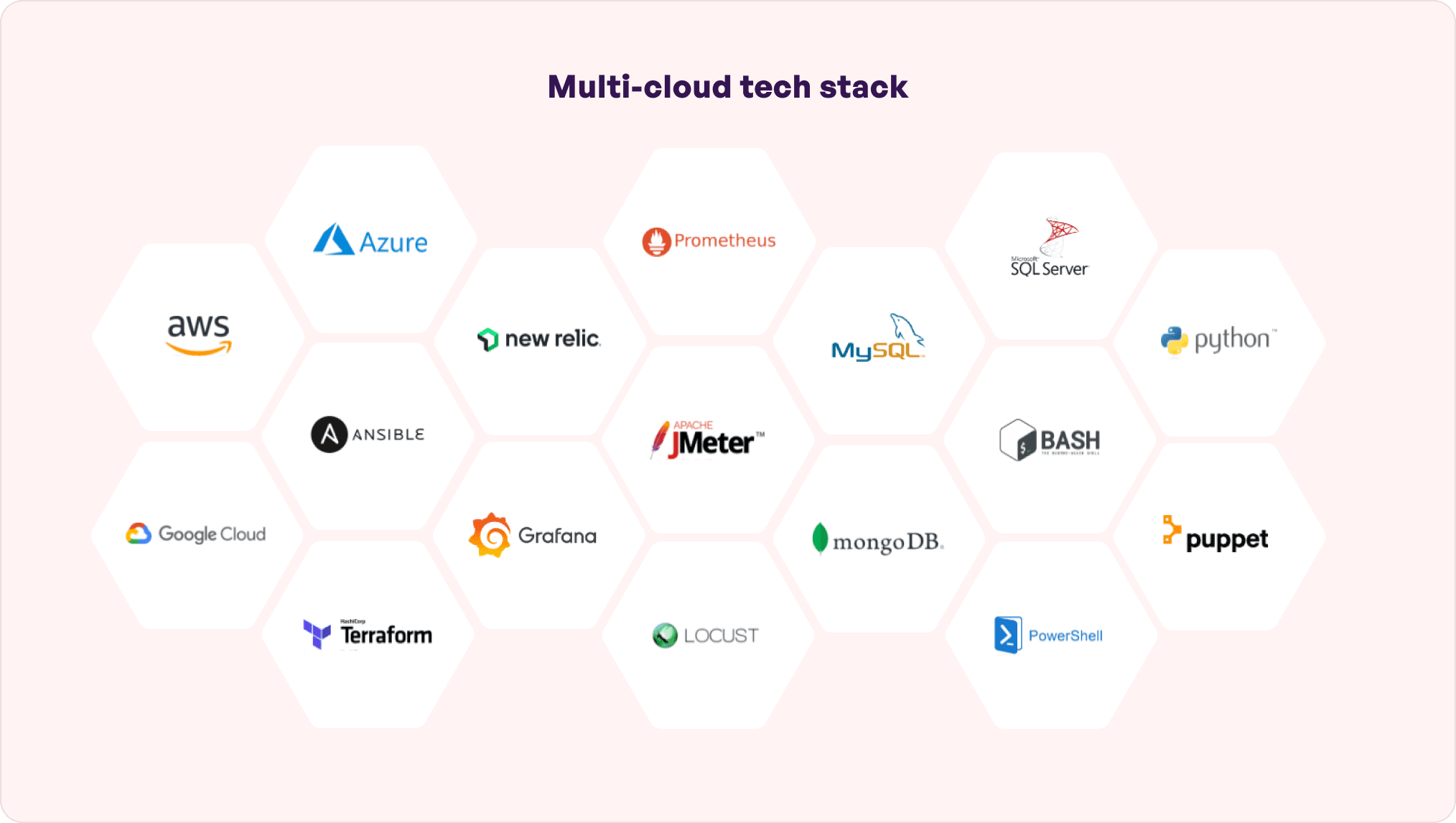
Setting up multi cloud: step-by-step process
A thoughtfully created multi-cloud strategy can help organizations across all sectors reach their operational goals in terms of security or data storage. In fact, cloud adoption is likely to become a necessity by 2028 with spending expected to surpass $1trillion by 2027.
Wondering how? Well, businesses can take advantage of the best features of each public cloud and optimize workloads on performance, reliability, speed, and compliance. So, let us look at how to implement multi cloud architecture in depth to boost productivity.
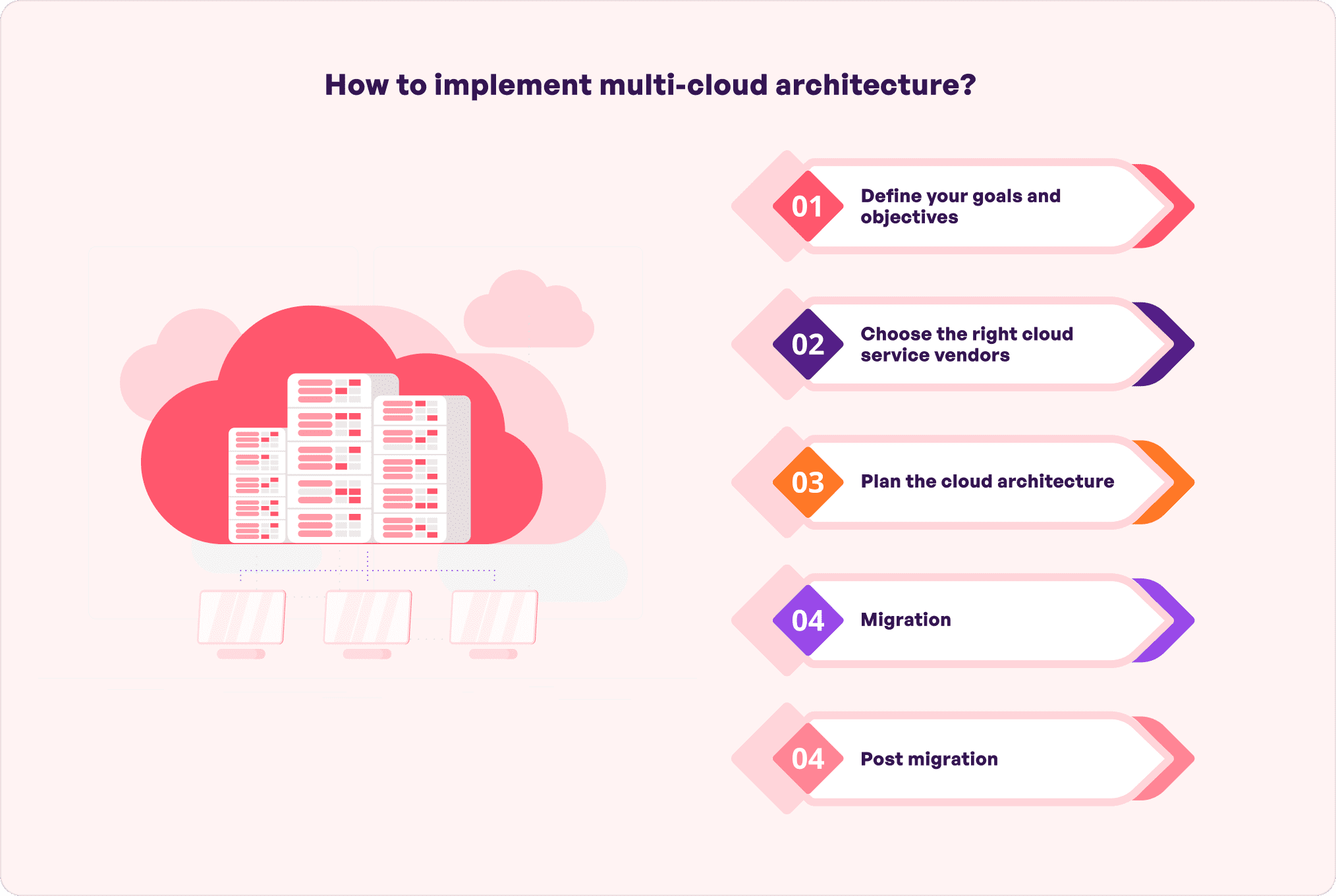
Step 1: Define your objectives
Stakeholders and business owners must join hands to decide a few significant aspects before considering a multi cloud option. For instance, how would it be useful if the organization needs to strengthen cybersecurity or embark on a global expansion? Below are a few other questions to raise
- the purpose of getting a multi-cloud
- customer demands and industry factors
- criticality and importance of different tasks
- management techniques you wish to adopt
- workload distribution and vendor choice
Step 2: Research your vendor
The vendor you pick depends on your security and scalability requirements, industry type, and the factors like costs and timeline. Hire developers at Simublade who are highly professional with years of experience under their belt to help you unleash the power of multi cloud solutions with 99% uptime and 0% downtime. We are all ears when businesses want to convey their ideas, confusions, and risks and provide answers to complex issues. Whether you wish to deploy private, public, or migrate to multi-cloud, partner with us to see exceptional outcomes and win the tech race.
Step 3: Plan the strategy
Convey your requirements and expectations to us and we will offer cloud computing services that are focused on bringing you to the right direction. Businesses can get an idea of costs, first-time cloud adoption tips, security risks and management techniques, and selected processes that must be moved to multi-cloud. If you are a mid-sized organization, we help maximize your cloud investment.
Step 4: Migration
We develop an effective plan to ‘migrate’ your workload and data with state-of-the-art tools, APIs, and powerful technologies within a timeline. This means moving data from on-premise or cloud environments to the selected multi-cloud architecture. The plan includes :
- checklist of critical components
- strategies to lower downtime
- potential repercussions of a disruption
- A robust recovery plan for each one of them.
Meticulous testing and validation are done during this transition to avoid unique complications that are native to specific cloud environments
Step 5: Post migration phase
This is an important step for the success of cloud migration by ensuring that the resources are working in accordance with business goals and targets. This is done by resource monitoring, performance upgrades, power balance, and frequent security checks along with fine tuning, optimization, training, documentation, and management. These are mandatory to avoid any hindrance in the overall operations.
What is the cost of multi-cloud migration?
It ranges between $5,000 to $500,000 depending on the scale of the workload. For instance, smaller workloads are typically less costly. However, infrastructure takes up a significant portion of the cloud migration expenses followed by the modification requirements and chosen strategy like re-architecting and rehosting.
How to ensure proper multi cloud cost management?
Trusted, genuine, and skilled experts like us at Simublade help with multi-cloud cost management so businesses can rest assured that the cloud services budget is never spiraling out of their hands. The management strategy includes :
- shutting down your unused resources after consultation
- cloud auto scaling as per server capacities
- routined audits of the cloud costs
- offering idea regarding how cloud budget is being spent
On your part, stay in constant touch with us, communicate your changing requirements and concerns over time, if any, and educate your team members thoroughly for the best use of the resources. Further, it is a good idea to be aware of the cloud infrastructure to see how different elements in it are in sync with your business purpose.
Conclusion: the bright future of multi cloud
Unmatched flexibility, best-of-breed vendors, rapid scalability, broad geographic coverage, and performance optimization are the top-tier benefits of multi-cloud strategy reshaping enterprise IT. Studies have found that 90% of large organizations have already implemented multi-cloud and this is likely to increase in the near future.
However, there are plenty of considerations when adopting this technology. So, it is important to understand what multi-cloud architecture is and why it can be fruitful. Further, partner with committed cloud specialists like us who are adept at handling cloud challenges and using the best practices for a successful migration.
FAQs
Q. How does multi cloud architecture work?
Ans. Multi-cloud architecture is when an organization uses the services of multiple public cloud providers to run applications.
Q. Why choose Simublade for multi-cloud architecture?
Ans. Simublade offers exceptional cloud consulting services including multi-cloud migration, deployment, and consultation to ensure 99% uptime and 0% downtime. Our cloud computing solutions and strategies are tailored to the unique needs of any business across diverse industries which smoothly optimizes growth, security, and performance. We work with a robust technology stack to help you provide nothing but the best.
Q. What are the security implications of multi cloud?
Ans. Security implications of multi cloud integration include regular audits, firewalls, single-pane-of-glass visibility, DDoS protection, and secure transfers. These help close gaps and avoid misconfigurations, data breaches, account hacking, and change control.
Q. What are the key features of Multi Cloud Architecture?
Ans. The key multi-cloud architecture features include software overlays, NaaS (Network-as-a-service), IaC (Infrastructure as code) , and programmability.


